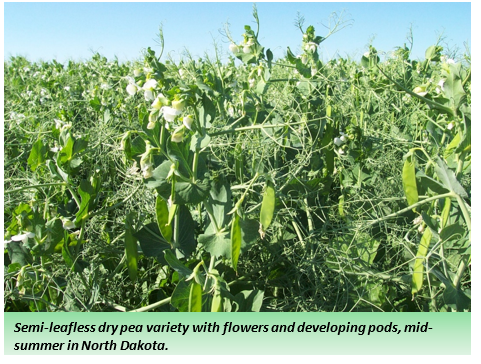Field Pea (05/12/22)
Field pea (Pisum sativum L.), a native of southwest Asia, was among the first crops brought under cultivation by man. The green- and yellow-seeded varieties are used for human consumption as dry split field pea. Field peas are used as protein concentrates for human consumption, in soups, for livestock and peas are popular pigeon feeds. In North Dakota pea yields can equal yields obtained by hard red spring wheat.
Field pea may be grown as a forage crop, for hay, pasture or silage. Field pea grown in a mixture with oat, barley or triticale yields more dry matter per acre than a straight pea crop. A mixture of 2/3 field pea and 1/3 oat can be seeded with alfalfa or clover as a companion crop. Harvest is recommended when field pea is in full bloom and oat is in the late boot stage.
Field pea stems grow to a length of 2 to 4 feet. A leaf consists of one to three pairs of leaflets with a terminal, branched tendril. Field pea is of the indeterminate (climbing) type or determinate (bush or dwarf) type. Flowers are reddish-purple or white. Pods are about three inches long and can contain four to nine seeds.
A cool growing season is necessary for optimum pea yields (a mean temperature of 55 degrees to 65 degrees F). Hot weather during flowering may result in reduced seed set. Field pea requires the same length of growing season as wheat. On average, it requires 60 days from planting until bloom and the crop matures in 95 to 100 days

The moisture requirement for field pea is similar to that for cereal grains. Field pea can be grown on a wide range of soil types, but in any soil, there must be good drainage, as field pea does not tolerate soggy or saturated conditions. Field pea is capable of utilizing bacterially fixed atmospheric nitrogen. The specific bacterial association for nitrogen fixation in field pea and lentils is with the bacterium Rhizobium leguminosarium. If field pea is to be grown in a field for the first time, or peas have not been grown recently, inoculation of the seed with the proper Rhizobium prior to planting may increase nodulation. Pea seed germination rate increases with increasing temperature. Seed treatment with a fungicide can significantly improve emergence.
Pea growers need to carefully monitor the crop as it nears maturity in order to harvest on a timely basis. Harvest time is especially important if the crop is to be marketed as seed, or to meet contract specifications for human food or specialty feed markets.
Short-vine and semi-leafless pea varieties have characteristics that are adaptable to straight harvesting compared to varieties with indeterminate and prostrate-vine growth.
For more production information see the ‘Pulse Crop Production Field Guide’ for North Dakota and for variety information see the ‘North Dakota variety trial results and selection guide’.
Extension Agronomist Broadleaf Crops
